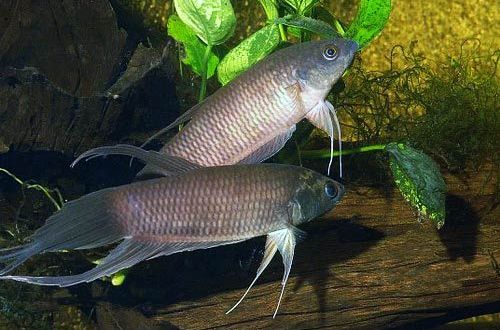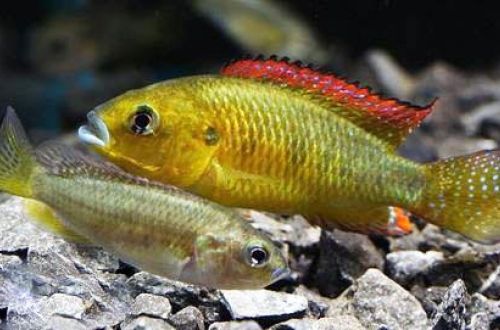
Betta Renata
Betta Renata or Cockerel Renata, scientific name Betta renata, belongs to the Osphronemidae family. Far from the brightest representative of the Fighting Fish, therefore, it does not arouse much interest among aquarists. But it is distinguished by a peaceful disposition and good compatibility with other fish that can live in similar conditions.

Contents
Habitat
It comes from Southeast Asia from the central and southern parts of the island of Sumatra from the territory of the Indonesian provinces of Jambi and Sumatra Selatan. They inhabit peat bogs and associated streams and rivers located in the midst of tropical rainforest. Little light penetrates through the dense crown of trees, so there is practically no aquatic vegetation, only along the banks there are thickets of mosses and ferns. The bottom of the reservoirs is covered with a layer of fallen leaves, tree branches and other snags. As a result of the decomposition of plant material, humic acids and other tannins are released into the water, coloring it in a rich brown color.
Brief information:
- The volume of the aquarium – from 80 liters.
- Temperature – 23-27°C
- Value pH — 4.0–6.0
- Water hardness – 0–5 dGH
- Substrate type – any dark
- Lighting – subdued
- Brackish water – no
- Water movement – little or no
- The size of the fish is about 8 cm.
- Food – any food
- Temperament – peaceful
- Content – alone, in pairs or in a group together with other fish
Description
Adults reach a length of about 8 cm. The fish have an elongated strong body. The main color is gray with slight dark pigmentation, the abdomen is light. The edge of the mouth has a dark outline. Males are larger and develop more extended fins.
Food
In nature, it feeds on zooplankton, small aquatic insects and their larvae, worms, etc. Acclimatized fish supplied for sale, as a rule, have adapted to accepting alternative products. The basis of the daily diet can be popular aquarium foods in dry, frozen and live form. Many manufacturers produce specialized feed for Cockerels.
Maintenance and care, arrangement of the aquarium
The optimal size of the aquarium for one pair or a small group of these fish starts from 80 liters. Since Betta Renata comes from tropical swamps, it would be quite appropriate to repeat the features of the natural habitat in the design, namely: a subdued level of lighting, the presence of numerous snags on dark ground, perhaps the addition of several shade-loving plants, as well as bedding from the leaves of some trees. The leaves are an excellent way to make the water look like a fish in nature, and also serve as the basis for the development of a useful colony of microorganisms, such as shoe ciliates – a valuable secondary food source for fry.
Successful long-term management is entirely dependent on providing a stable aquatic environment within an acceptable range of temperatures and hydrochemical values. Fish need warm, acidic and soft water, they do not tolerate excessive accumulation of organic waste (food leftovers, excrement). The desired stability is achieved through the smooth operation of the installed equipment and regular maintenance of the aquarium, the most important of which is the weekly replacement of part of the water with fresh water at 15-20% of the volume. Newly added water should have similar pH and dGH values.
Behavior and Compatibility
It belongs to the group of fighting fish, however, in this case it is nothing more than a classification. Cockerel Renata is not aggressive and has a peaceful disposition towards other fish. Intraspecific relationships are built on the dominance of males in the territory. The struggle for hierarchy in the group is sometimes accompanied by a demonstration of strength, but it does not come to skirmishes.
Breeding / breeding
The fish have evolved unusual adaptations to keep their brood in a highly competitive environment. They do not form clutches at the bottom or among plants, but hatch eggs in their mouths, and males do this. During spawning, accompanied by close hugs, when the fish wrap themselves around each other, the eggs end up in the mouths of both parents, but at the end the female passes them on to her partner. The male retires to a quiet place on the periphery of the aquarium away from other fish, while the female protects him from potential threats. The incubation period lasts 17–20 days, after which fully formed fry appear, ready to accept microscopic food, such as brine shrimp nauplii. It is worth noting that young males often swallow eggs or release them ahead of time if they were frightened or stressed.
Thus, breeding is quite simple, the only difficulty is related to the preservation of fry, which need not only suitable food, but also to provide a warm, moist layer of air above the surface, which is necessary for the normal development of the labyrinth organ of the fish.
Fish diseases
The cause of most diseases is unsuitable conditions of detention. A stable habitat will be the key to successful keeping. In the event of symptoms of the disease, first of all, the quality of the water should be checked and, if deviations are found, measures should be taken to correct the situation. If symptoms persist or even worsen, medical treatment will be required. Read more about symptoms and treatments in the Aquarium Fish Diseases section.





